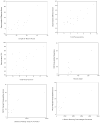Delay discrimination and reversal eyeblink classical conditioning in abstinent chronic alcoholics
- PMID: 18331162
- PMCID: PMC2441839
- DOI: 10.1037/0894-4105.22.2.196
Delay discrimination and reversal eyeblink classical conditioning in abstinent chronic alcoholics
Erratum in
- Neuropsychology. 2009 Mar;23(2):157
Abstract
Evidence has shown that alcoholism leads to volume reductions in brain regions critical for associative learning using the eyeblink classical conditioning paradigm (EBCC). Evidence indicates that cerebellar shrinkage causes impairment in simple forms of EBCC, whereas changes in forebrain structures result in impairment in more complex tasks. In this study, the ability of abstinent alcoholics and matched control participants to acquire learned responses during delay discrimination and discrimination reversal was examined and related to severity of drinking history and neuropsychological performance. During discrimination learning, one tone (CS+) predicted the occurrence of an airpuff (unconditioned stimulus), and another tone (CS-) served as a neutral stimulus; then the significance of the tones was reversed. Alcoholics who learned the initial discrimination were impaired in acquiring the new CS+ after the tones reversed; this is a function that has previously been linked to forebrain structures. It is suggested that a factor important to alcoholic addiction may be the presence of alcoholic-related associative responses that interfere with the ability to learn new more adaptive associations.
Figures




References
-
- Akase E, Thompson LT, Disterhoft JF. A system for quantitative analysis of associative learning. Journal of Neuroscience Methods. 1994;54:119–130. - PubMed
-
- American Psychiatric Association. Diagnostic and statistical manual of mental disorders. 4. Washington, DC: Author; 1994.
-
- Arendt T. Impairment in memory function and neurodegenerative changes in the cholinergic basal forebrain system induced by chronic intake of ethanol. Journal of Neural Transmission. 1994;44(Suppl):173–187. - PubMed
-
- Arendt T, Allen Y, Marchbanks RM, Schugens MM, Sinden J, Lantos PL, et al. Cholinergic system and memory in the rat: Effects of chronic ethanol, embryonic basal forebrain brain transplants and excitotoxic lesions of cholinergic basal forebrain projection system. Neuroscience. 1989;33:435–462. - PubMed
-
- Arendt T, Allen Y, Sinden J, Schugens MM, Marchbanks RM, Lantos PL, et al. Cholinergic-rich brain transplants reverse alcohol-induced memory deficits. Nature. 1988 March;332:448–450. - PubMed

